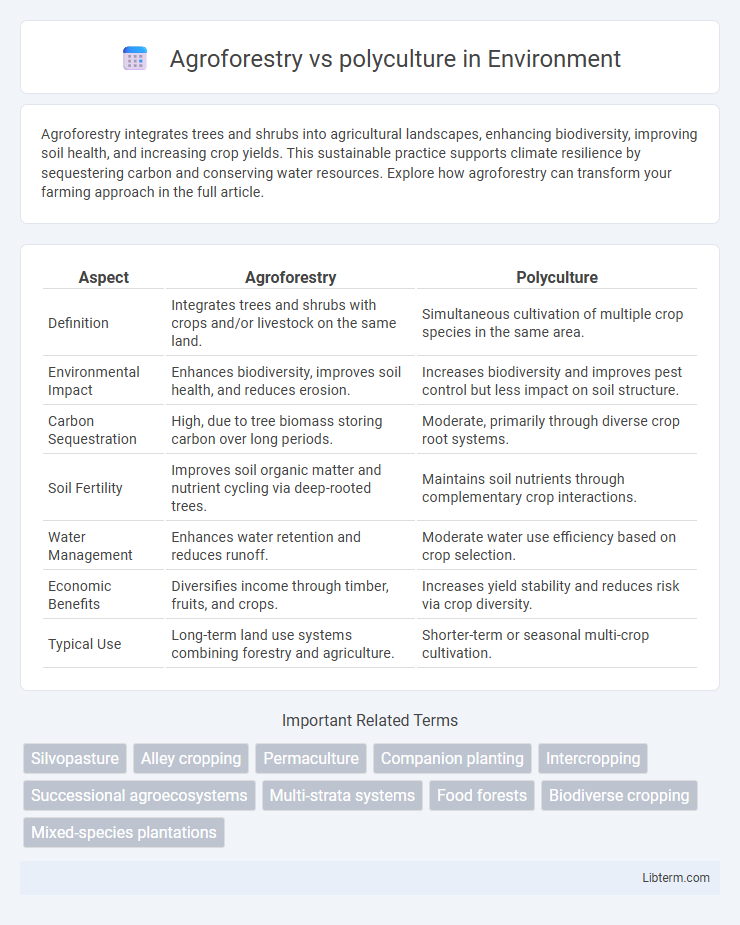Agroforestry integrates trees and shrubs into agricultural landscapes, enhancing biodiversity, improving soil health, and increasing crop yields. This sustainable practice supports climate resilience by sequestering carbon and conserving water resources. Explore how agroforestry can transform your farming approach in the full article.
Table of Comparison
| Aspect | Agroforestry | Polyculture |
|---|---|---|
| Definition | Integrates trees and shrubs with crops and/or livestock on the same land. | Simultaneous cultivation of multiple crop species in the same area. |
| Environmental Impact | Enhances biodiversity, improves soil health, and reduces erosion. | Increases biodiversity and improves pest control but less impact on soil structure. |
| Carbon Sequestration | High, due to tree biomass storing carbon over long periods. | Moderate, primarily through diverse crop root systems. |
| Soil Fertility | Improves soil organic matter and nutrient cycling via deep-rooted trees. | Maintains soil nutrients through complementary crop interactions. |
| Water Management | Enhances water retention and reduces runoff. | Moderate water use efficiency based on crop selection. |
| Economic Benefits | Diversifies income through timber, fruits, and crops. | Increases yield stability and reduces risk via crop diversity. |
| Typical Use | Long-term land use systems combining forestry and agriculture. | Shorter-term or seasonal multi-crop cultivation. |
Introduction to Agroforestry and Polyculture
Agroforestry integrates trees and shrubs into crop and livestock systems, enhancing biodiversity, soil fertility, and carbon sequestration. Polyculture involves cultivating multiple crop species simultaneously or sequentially on the same land, promoting pest resistance and improving resource use efficiency. Both systems contribute to sustainable agriculture by diversifying production and maintaining ecosystem health.
Defining Agroforestry: Key Principles and Practices
Agroforestry integrates trees and shrubs into agricultural landscapes to enhance biodiversity, soil health, and crop productivity through sustainable land-use systems. Key principles include diverse plant species combinations, spatial and temporal diversity, and ecological interactions that promote nutrient cycling and pest control. Practices such as alley cropping, silvopasture, and forest farming exemplify how agroforestry balances ecological and economic benefits.
What Is Polyculture? Concepts and Techniques
Polyculture refers to the agricultural practice of growing multiple crops or plant species simultaneously in the same space, enhancing biodiversity and resilience. Techniques include intercropping, crop rotation, and companion planting, which improve soil health, pest control, and yield stability. Unlike agroforestry, which integrates trees with crops or livestock, polyculture primarily focuses on combining diverse herbaceous plants to maximize resource use and ecological balance.
Historical Context of Agroforestry and Polyculture
Agroforestry, practiced for millennia in regions like Southeast Asia and Central America, integrates trees and shrubs with crops or livestock to enhance biodiversity and soil health. Polyculture, also an ancient method, involves cultivating multiple crop species simultaneously in the same space, exemplified by traditional Native American "Three Sisters" farming. Both systems reflect sustainable land-use practices developed to optimize resource use, resilience, and food security in diverse cultural and environmental contexts.
Ecological Benefits: Comparing Biodiversity Impacts
Agroforestry enhances biodiversity by integrating trees, crops, and livestock, creating diverse habitats that support various species and improve ecosystem resilience. Polyculture promotes species diversity within crop systems, reducing pest outbreaks and enhancing soil health. Both methods significantly boost ecological benefits, but agroforestry's inclusion of woody perennials often results in greater biodiversity impacts compared to polyculture alone.
Economic Viability: Profitability and Sustainability
Agroforestry systems integrate trees and shrubs with crops or livestock, enhancing long-term economic viability through diversified income streams and improved ecosystem services that reduce input costs. Polyculture involves growing multiple crop species simultaneously, boosting short-term profitability by maximizing land use efficiency and crop yields but often requiring intensive management. While agroforestry promotes sustainability via soil conservation and carbon sequestration, polyculture sustainability depends on crop selection and management practices, influencing market stability and resilience against economic fluctuations.
Soil Health and Erosion Control in Both Systems
Agroforestry enhances soil health by integrating trees with crops, which improves nutrient cycling, increases organic matter, and stabilizes soil structure, effectively reducing erosion through root reinforcement and canopy cover. Polyculture promotes diverse plant root systems that improve soil microbial activity and nutrient availability, while minimizing erosion by maintaining continuous ground cover and protecting soil from wind and water forces. Both systems contribute to sustainable land management, but agroforestry offers deeper root networks and shade benefits that significantly enhance soil moisture retention and long-term erosion control.
Climate Resilience: Adapting to Environmental Change
Agroforestry integrates trees with crops and livestock, enhancing climate resilience by improving soil structure, increasing biodiversity, and providing shade that reduces heat stress and conserves moisture. Polyculture systems, which involve cultivating multiple crop species simultaneously, boost ecosystem stability and pest resistance, allowing for better adaptation to variable weather patterns and extreme events. Both practices contribute to carbon sequestration and nutrient cycling, crucial for mitigating the impacts of climate change and promoting long-term agricultural sustainability.
Challenges and Limitations of Agroforestry vs Polyculture
Agroforestry faces challenges such as complex land management, slower economic returns due to longer tree growth cycles, and competition between trees and crops for water and nutrients. Polyculture's limitations include increased labor intensity, potential for pest and disease spread among mixed species, and difficulties in mechanization and scaling. Both systems require detailed knowledge of species interactions and site-specific conditions to optimize productivity and sustainability.
Choosing the Right System: Factors for Farmers and Land Managers
Selecting between agroforestry and polyculture depends on land size, crop diversity goals, and environmental conditions. Agroforestry integrates trees with crops or livestock, enhancing biodiversity, improving soil health, and providing long-term economic returns. Polyculture emphasizes multiple crop species grown simultaneously, optimizing land use efficiency, pest control, and immediate agricultural productivity.
Agroforestry Infographic

 libterm.com
libterm.com